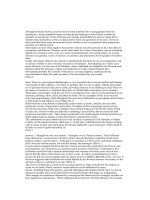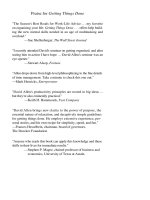The art of styling sentences
Bạn đang xem bản rút gọn của tài liệu. Xem và tải ngay bản đầy đủ của tài liệu tại đây (4.24 MB, 289 trang )
TableofContents
TitlePage
CopyrightPage
Preface
Introduction
SuggestionsfortheInstructor
SuggestionsfortheStudent
CHAPTER1-TheSentence
WHATEXACTLYISASENTENCE?
SOMEHELPFULREFERENCES
CHAPTER2-TheTwentyPatterns
NOWLET’SMAKESENTENCESGROW...
COMPOUNDCONSTRUCTIONS
WHENTOUSETHISPATTERN
PATTERN1A
PATTERN1B
PATTERN1C
WHENTOUSETHISPATTERN
WHENTOUSETHISPATTERN
SENTENCESWITHSERIES
WHATISASERIES?
WHENISASERIESHELPFUL?
REPETITIONS
WHATAREREPETITIONS?
WHYUSEREPETITIONS?
HOWDOYOUCREATEREPETITIONS?
WHEREISREPETITIONAPPROPRIATE?
HOWDOESPUNCTUATIONAFFECTYOURMESSAGE?
MODIFIERS
INVERSIONS
ANASSORTMENTOFPATTERNS
CHAPTER3-SentencesGrow
STYLE
COMBININGTHEPATTERNS-TENWAYS
EXPANDINGSENTENCES
MYTHSABOUTCOORDINATORS
ASENTENCEWITHSPECIALEMPHASIS:THEPERIODICSENTENCE
CHAPTER4-FigurativeLanguageinSentences
FIGURESOFSPEECH
FURTHERREADING
CHAPTER5-TheTwentyPatterns—InPrint
TOUGHCOUNTRY
EXCERPTFROMATHOUSANDDAYS
PLACEOFSORROWS
Appendix:
Index
©Copyright2002,1993,1983,1972byBarron’sEducationalSeries,Inc.
Allrightsreserved.
Nopartofthisbookmaybereproduced
inanyform,byphotostat,microfilm,xerography,
oranyothermeans,orincorporatedintoany
informationretrievalsystem,electronicor
mechanical,withoutthewrittenpermission
ofthecopyrightowner.
Allinquiriesshouldbeaddressedto:
Barron’sEducationalSeries,Inc.
250WirelessBoulevard
Hauppauge,NewYork11788
LibraryofCongressCatalogCardNo.2002018477
InternationalStandardBookNo.0-7641-2181-2
LibraryofCongressCataloging-in-PublicationData
Longknife,Ann.
Theartofstylingsentences:20patternsforsuccess/AnnLongknife,K.D.Sullivan.—4thed.
p.cm.
Rev.ed.of:Theartofstylingsentences/MarieL.Waddell...[etal.]3rded.c1993.
Includesindex.
ISBN0-7641-2181-2
1.Englishlanguage—Sentences.2.Englishlanguage—Rhetoric.
1.Sullivan,K.D.II.Waddell,MarieL.Artofstylingsentences.III.Title.
PE1441.L572002
428.2—dc21
2002018477
PRINTEDINTHEUNITEDSTATESOFAMERICA
9876543
DI N ĐÀN H C TI NG ANH - Admin: TR N M NH TRUNG
< />TÀI LI U LUY N IELTS - Admin: TR N M NH TRUNG
< />
Preface
Theauthorsoftheoriginaltextcompiledtheirbooktohelpstudentsimprovetheirwritingstyle.The
principles they advocated—and that have been used throughout history—of learning to write by
imitatingpatterns,arestillvalidtoday,asshowninthisrevisedfourthedition.Theydevisedtheidea
of the book from their extensive classroom experience, and we have built on that from our own
classroomandeditingexperience.
Inhertwenty-fiveyearsofteaching,Dr.AnnLongknifehastaughtavarietyofEnglishcourses—
literature, poetry, and all forms of composition courses from English as a Second Language to
CriticalThinking.Annisalsoafreelanceeditorforanumberofpublications,includingtheon-line
magazineLineZine,andhasbeeninlovewithEnglishanditspossibilitiessinceshestartedreadingat
agefour.
K.D. Sullivan, as founder and owner of Creative Solutions Editorial, Inc., a global editorial
servicescompany,hasworkedwith,andcorrected,awidevarietyofwritingstylesinmorethan100
different industries. She is the author of Go Ahead ... Proof It! (Barron‘s, 1996), and coauthor with
Michelle Goodman of the upcoming In the Driver’s Seat: A Roadmap to Freelancing. She is also
developingabookseries,GoAhead..._____!, designed to cover a wide range of specific business
topics. A popular seminar leader and trainer, K.D. regularly designs and implements proofreading
workshopsandcorporatetrainingprogramsthroughouttheUnitedStatesandCanada.Sheisknown
forproducingclear,error-freewrittencommunications.
In this new edition we have expanded some of the grammar references to more nearly reflect
currentknowledgeandusage.Wehavealsoupgradedmanyoftheprofessionalexamplestoillustrate
howcurrentwritersregularlycontinuetousethesepatterns.
Although the idea of the book is to learn by imitating the patterns, that technique is only the
beginning.We,asdidtheoriginalauthors,hopethatstudentswillfindnewwaysofbeingplayfulor
serious,dramaticorforcefulastheywrite.Aboveall,wewantthemtotakeriskswithpatternsthey’ve
nevertriedbefore,toclaimauthorityfortheirindividualstyle,andtodeveloptheirownvoice.
AtBarron‘s,wehaveappreciatedthegraciousandprofessionalguidanceofoureditor,MaxReed,
inpreparingthisnewedition.WewouldliketothankDianeRoth,copyeditor.Hersuggestionsmade
goodsenseandstrengthenedourpresentation.
We’ve included a very valuable addition in this version that was absent in previous editions—an
Index—tohelpmoreeasilyguidethestudentinthereferenceprocess.DQJohnson’sexpertiseinthe
indexingfieldisawelcomeadditiontoanyproject.K.D.wouldalsoliketothankDeirdreGreene,her
CreativeSolutionsmanager,whocontinuallykeepsthebusinessgoingsobeautifully,allowingK.D.
toconcentrateonthisbookandthemultitudeofotherprojectssheenjoys.
AnnLongknife
K.D.Sullivan
SANFRANCISCO
JULY2002
Introduction
Almostanyonecanbenefitbylearningmoreaboutwritingsentences.Youdon’thavetobeastudent
to benefit from this book; you just need the desire to write well. You must certainly want to create
bettersentences,oryouwouldnotbereadingthispage.Ifyoualreadyknowhowtowritegood,basic
sentencesbutfeeltheystilllacksomething,thattheyhavenovariety,nostyle,thenthisbookisfor
you.
Buthowdoyougoaboutwritingbettersentences?Theanswerissimple.Youlearntowritebetter
sentencesasyoulearnalmosteveryotherskill:byimitatingtheexamplesofthosewhohavethatskill.
Youprobablyhavealreadydiscoveredthatitiseasiertomasteranything—jumpinghurdles,doinga
swandive,orplayingtheguitar—ifyouimitateamodel.Nowhereisthisprinciplemoreobviousthan
inwriting.Ifyouarewillingtoimproveyourwritingskillsbycopyingmodelsofclearsentences,the
followingfivechapterswillhelpyoumastertheskillofwritingwell,withgraceandstyle.
THEWHOLEISTHESUMOFITSPARTS
CHAPTER 1 briefly reviews what constitutes a sentence. If you need to review the functions of
differentpartsofasentence,youmayneedasupplementarybookwithafullerdiscussionofsentence
structure.Thischaptercoversthevariouspartsofthesentence,utilizingthetraditionaltermsyouwill
findintheexplanationsofthepatternsinCHAPTER2.
SKILLCOMESFROMPRACTICE
CHAPTER2,theheartofthisbook,containstwentydifferentsentencepatterns,somewithvariations.
Studythegraphicpictureofeachpattern(thematerialinthenumberedboxes)andnoticetheprecise
punctuation demanded for that pattern; you will then be able to imitate these different kinds of
sentences.TheexplanationundereachboxedpatternwillfurtherclarifyHOWandWHENyoushould
usethatparticularpattern;theexampleswillgiveyoumodelstoimitate;theexerciseswillprovide
practice.Withtheseasguides,trywritingandrevisinguntilyoumastertheskillofconstructingbetter
sentences.
As you revise, take some of your original sentences and rewrite them to fit a number of these
patterns.Thistechniquemayatfirstseemtoodeliberate,toocontrivedanattemptatanartificialstyle.
Some of the sentences you create may not seem natural. But what may seem artificial at first will
ultimatelybethemeanstogreatereaseinwritingwithflairandstyle.
CLEARWRITINGCOMESFROMREWRITING
Your first draft of any communication—letter, theme, report (either written or oral)—will almost
alwaysneedrevision.Whenyoufirsttrytoexpressideas,youaremainlyinterestedincapturingyour
elusivethoughts,inmakingthemconcreteenoughonasheetofpaperforyoutothinkaboutthem.An
importantstepinthewritingprocess—infact,wherewritingreallybegins—isrevision,anongoing
process.Youmustworkdeliberatelytoexpressyourcapturedideasinclearandgracefulsentences.
COMBINATIONSLEADTOENDLESSVARIETY
CHAPTER 3 will give you some tips on style and show you how some of the basic twenty styling
patternsinCHAPTER2cancombinewithotherpatterns.Studytheexamplesgivenanddescribedin
CHAPTER3;thenletyourimaginationguideyoutomakingeffectivecombinationsofthedifferent
patterns.
Analyze the sentences from professional writers to discover rhetorical subtleties and ways of
achievingclarity,style,andvariety.
IMAGINATIONISONECORNERSTONEOFSTYLE
CHAPTER4willshowyouhowtoexpressyourthoughtsinimaginative,figurativelanguage.Study
the pattern for each figure of speech described there, and then insert an occasional one—simile,
metaphor, analogy, allusion, personification, hyperbole—into your own writing. Or you might
experiment with an ironical tone. Be original; never merely echo some well-known, ready-made
cliché.Createnewimagesfromyourownexperiences.
UNDERSTANDINGCOMESFROMANALYSIS
CHAPTER5containsexcerptsfromtheworksofexperiencedwriterswhohaveincorporatedpatterns
liketheonesdescribed.Studythemarginalnotesthatgivethepatternnumbersyouhavelearnedfrom
studyingCHAPTER2.Thenanalyzesomethingyouarereading;discoverforyourselfhowwriters
handletheirsentencesandtheirpunctuation.Don’tbeafraidtoimitatethemwhenyouwrite.Youwill,
ofcourse,find“patterns”(arrangementsofwordsinsentences)thatarenotinCHAPTER2ofthis
book.Imitateothersaswellasthetwentywepresent.
SuggestionsfortheInstructor
Sincethismethodofteachingstudentstowritebyimitationmaybenewtosomeinstructors,wehope
this section will offer helpful and practical suggestions. For the new teacher, we want to anticipate
possiblequestionsandprovidesomeclassroomguidelines;fortheexperiencedteacher,wehopeto
offerafreshapproachtoanoldproblem:gettingstudentstowritepapersthatarenotdullandboring
forthemtowriteorforustoread.Thefollowingpagescontainsomehintsforwaysofteachingthe
materialinCHAPTERS1and2.Additionalpagesaddressedtostudentsalsosuggestvaluableways
fortheteachertopresentthepatternsandothertechniquestoaclass.
SENTENCECOMBINING
Concurrently with publication of the first edition of The Art of Styling Sentences, a number of
researchersdevelopedateachingtechniquequitedifferentfromthe“imitation”methoddescribedin
thisbook—sentencecombining.IntroducedfirstbyJohnMellonandlaterdevelopedintheworkof
FrankO‘Hare,WilliamStrong,DonaldDaiker,andothers,thistechniquederivesfromanumberof
sentences—usually short, simple, kernel sentences—a pattern for combining them into one or two
longersentences.Throughthistypeofpractice,thestudentdevelopssyntacticmaturity.Theresultof
thismethodiseffectiveskillbuilding;students’sentenceshavegreatervariety,appearmoremature
and sophisticated, and illustrate how writers in the same class, working with the same kernels, are
abletotransformthemintomanydifferenttypesofeffectivecommunication.
SUGGESTIONSFORTEACHINGCHAPTER1
As we said in the introduction, CHAPTER 1, “The Sentence,” does not pretend to be a complete
discussionofsentencestructure.TheEnglishsentencetookseveralcenturiestodevelopandis,asSir
WinstonChurchillsaid,a“noblething”indeed.Thereareentirebooksdedicatedtoanexplanationof
it;henceourcoverageisminimal.
The main thing to do with CHAPTER 1 is to review with your class the important “slots” in the
standardsentence—subject,verb,object,complement,modifier,andconnector.Besurethestudents
understandthetermsandthefunctionsofeach.Givethemsomeclasspracticeinseparatingsubjects
fromverbsintheircurrentreading.Itissometimeseasierforthemtofindtheessentialskeletonof
the sentence if they first cross out, or put in parentheses, all the prepositional phrases (which are
usually modifiers, anyway). They can take these from their current reading—a textbook, the sports
page,anadvertisement,lyricsofapopularsong,orthelabelonaketchupbottle,orasodacan!This
isaneffectiveexercisebecauseprepositionalphrasesarenearlyalwaysmodifiersandalmostnevera
partofthebasicsentence.Thenletthemdiscussthedifferencesbetweenphrasesandclauses,between
independent and dependent structures, between declarative and imperative sentences. Never assume
thatstudentswillbeadeptatthiskindofanalysis.Guidethemcarefullywithdetailedexplanationsand
manyexamples.
SUGGESTIONSFORTEACHINGCHAPTER2—THE
PATTERNS
CHAPTER2,“TheTwentyPatterns,”istheheartofthisbookandcontainsenoughmaterialtokeep
yourstudentsbusythroughoutthesemesterastheyincorporatethematerialintotheircompositions.
Paceyourdiscussionstofityourclass;don’tgofasterthanyourstudentscanmasterthetechniques,
and never try to cover more than three patterns in any one class period. Since there is a logical
grouping and arrangement of the patterns, you may find it easier to go straight through from
PATTERN1toPATTERN20.
You will need to explain each of these patterns in great detail; you will also need to justify the
rationale of the punctuation. Before you start with PATTERN 1, write some sentences on the board
andreviewthesentencestructurefromCHAPTER1.
Now, with your class, create appropriate graphic symbols to use when you analyze and discuss
sentences. For example, you can use a double bar (II) to separate subject and verb in independent
clauses,orbracketstosetoffdependentclauses.
1.Drawonelineunderthemainclause(inthiscase,theentiresentence):Theeventsof9/11II
explodedouroldworldandpropelledusintoanewera.
2.Dramatizewhathappenswhentherearetwoindependentclausesinthesamesentence:
The events of 9/11 II shattered our old world (into smithereens): it II suddenly propelled us
(into a completely new kind) (of world). Draw a circle between the two independent clauses
(whichcouldbeseparatesentences);thenexplainthatonlyfourthingscanreplacethecircle:
a.aperiod,whichwouldseparatetheclausesintotwosentences;
b.acoordinatingconjunction(for,and,nor,but,or,yet,so)—whichcanberemembered
withthemnemonicFANBOYS—precededbyacomma;
c.asemicolon,sometimesfollowedbyaconnectivesuchasthereforeorhowever;
d.acolon,butonlyifthesecondclauseexplainsorextendstheideaofthefirst.
3.Usebracketstosetoffadependentclause,andclarifyitsfunctionasPARToftheindependent
clause;useasinglebartoseparatethesubjectandtheverbinthedependentclause:
MarcieIIbought[whateversheIwanted].
(nounclauseusedasdirectobject)
[WhatTatumIneeds]IIismorediscipline.
(nounclauseusedassubject)
ThelittlechildrenIIplayed[wherethefallenleavesIwere
deepest.]
(dependentadverbialclause)
4.Useawavylineunderanabsolutephrase:
Thewarbeingoveratlast,thetask(ofarrangingthepeaceterms)∥began.
5.Useacirclearoundconnectorsandothernonfunctionalterms.
Next,itmightbefuntoshowthattheseconstructionsworkevenwithnonsensewords.Provideone
ortwoexamples,andthenletstudentsputtheirowncreationsontheboardandexplainthem.
Abronslysartian||swazzled(alongthetentiveclath).
YesterdayI||thrombled(downthenat-fleuzedbeach)[whereglorphsandmizzlesIlay(inthe
sun)].
After this review, the class should be ready to tackle the first group of sentence patterns—the
compounds. Each of them is really just two sentences in one, but you must make clear the vast
differencesthatarepossible.NowisthetimetohavetheclassreallymastertheCheckpointsunder
PATTERN3,whichcoverthedifferencesinthethreecompounds.
Forexercisesbeyondthosethataccompanythepatternexplanations,considertheseideas:
1.Followyourdiscussionofparticularpatternsbyaskingstudentstowritetensentencesoftheir
ownusingthepatternsyouassign.Havestudentslabeleachsentencewiththenumberofthe
pattern in the left margin. The advantage of this book is the control you have through the
patternnumbers.Forsubjectmatterstudentscandrawupontheirreading,hobbies,sports,and
otherinterests.Ifforanygivenassignmenttheentireclassusesthesametopicoridea,have
thestudentscomparehowmanydifferentarrangementsofwordscanexpressthesameidea,
buteachwithslightlydifferentemphasisorrhythm.
2.UseSENTENCEPATTERN1,thecompoundwithasemicolonandwithoutaconjunction,to
teachortotestvocabulary.InthefirstclauseofthecompoundsentencehavestudentsUSEand
UNDERLINEthegivenword;inthesecondclausehavethemDEFINEthatword.
EXAMPLE:
ZenBuddhismisanesotericphilosophy;onlytheinitiatedreallyunderstandit.
ORTHISVARIATION:
TheGreekrootchronomeans“time”;achronometermeasurestimeaccurately.(Seehow
muchyoucanteachaboutpunctuationinasentencewiththisstructure!)
3.Assigntenvocabularywords,eachtobewritteninadifferentsentencepattern.Havestudents
underline the vocabulary word and label the pattern by number in the left margin. When
studentsgivethepatternnumberofthestructuretheyareimitating,youcanchecktheaccuracy
oftheirunderstandingofthepatternatthesametimeyouarecheckingthevocabularyword.
4.Requirestudentstohaveatleastonedifferentpatternineachparagraphoftheircompositions.
Have them write the number of the pattern they are imitating in the left margin. See
“Marginalia: to encourage deliberate craftsmanship” (pp. xv-xvi) for more ways of
encouragingstudentstoanalyzetheirwritingastheyimprovetheircraftsmanship.
5.Havestudentscollectinterestingsentencesfromtheirreadingandmakeabookletoffifteenor
twentynewanddifferentpatterns,withnomorethantwoorthreesentencesplusanalysison
eachpage.Theymaysimplycopysentencestheyfind,ortheymayclipandpastethemintheir
booklets,leavingroomforadescription(analysis)ofeachsentenceintheirownwords.
6. Take a long, involved sentence from the assigned reading; have your students rewrite it
several times using four or five different sentence patterns. (These revisions may have to
containsomewordsthattheoriginaldoesnothave.)Havestudentsreadthesesentencesaloud
inclass,commentingonthevariouseffectsthusachieved.
7.PointouttheeffectivenessofincorporatingPATTERN8(theonewithtwoorthreedependent
clauses)intoathesisorofusingittoforecastmainpointsintheintroductionortosummarize
intheconclusion.
8.Towardtheendoftheterm,aftertheyhavemasteredthepatternsandknowthembynumber,
havestudentsanalyzesomeoftheircurrentreading,evenfromothercourses.Havethemwrite
in the margin the numbers of the sentence patterns they find. (See CHAPTER 5 for two
examples.)
9. Some of the example sentences for analysis are from professional writers; they are often
convoluted and excessively detailed. Yet they can be springboards for discussion of such
thingsasstyle,punctuation,sentencelength,levelandappropriatenessofvocabulary,content,
orevenhistoricalinformation.
10.Attheendoftheterm,havethestudentscomparetheirfirstattemptstotheircurrentefforts.
They’llbesurprised(andpleased)toseetheimprovement.
DI N ĐÀN H C TI NG ANH - Admin: TR N M NH TRUNG
< />TÀI LI U LUY N IELTS - Admin: TR N M NH TRUNG
< />
SuggestionsfortheStudent
HOWTOGETTHEMOSTFROMTHISBOOK
Thesuggestionsandexercisesbelowmayseemtoosimpleortooartificialatfirstsight,butifyou
makeagameofplayingaroundwithwords,offittingthemtoaformula,youwilllearnhowtowrite
sentencesthathaveflairandvariety,andthatisaskillworthdeveloping.Awell-constructedsentence
is,likeanyartfuldesign,theresultofsoundcraftsmanship;itactuallyinvolvesandrequires:
a.goodcomposingorconstruction
b.appropriatepunctuation
c.afeelingfortherhythmoflanguage
d.anunderstandingofidiom
e.clarityofexpression
f.recognitionofthepoweroflogicalarrangement
If you are not in a composition class, but are working alone without a teacher ’s guidance, the
suggestionsbelowwillhelpyoutogetthemostoutofthisbook,sofollowthemcarefully.Don’tbe
afraidtocopyapatternandfityourownwordsintoit.Rememberthateverygreatcraftsmanbegins
asanapprenticeimitatingamaster.Byfollowingthesuggestionsbelowandmasteringthepatterns,
youwillincreaseyourskillintheartofstylingsentences.
1. Study one pattern at a time. Write four or five sentences that follow that pattern exactly,
especiallythepunctuation.GothroughalltwentypatternsinCHAPTER2,takingonlyoneata
time, until you are confident you understand the structure and the punctuation. Practice,
practice—andmorepractice;thisistheonlywaytolearn.
2. In every paragraph you write, try to incorporate one or more of these patterns, especially
when you find yourself tending to write short, simple sentences having the same kind of
subject-verb structure. Keep trying to improve the quality and arrangement of all of your
sentences,whethertheyfollowoneofthesepatternsornot.
3. Think of something you want to say and then practice writing it in three or four different
ways,noticingthechangesineffectandtonewhenyouexpressthesameideawithdifferent
patternsandpunctuation.Sinceyoumaynotbeawareofthesechangeswhenyoureadsilently,
readaloudoftentotrainyourear.
4. Analyze your reading material for eye-catching sentences, ones that you think have striking
patterns you could imitate. (CHAPTER 5 shows you how.) Whether reading a newspaper, a
magazine article, or a skillfully styled literary work, you will find many sentences so well
writtenthatyouwillwanttoanalyzeandthenimitatethem.Underlinethem;learnthepattern.
Or from your reading make a collection of sentences that you have especially enjoyed. Or
keepaspecialnotebookofnewanddifferentpatternsthatyouwanttocopy.Inshort,lookfor
unusual and effective sentences in everything you read and make a conscious effort to add
thosenewpatternstothebasictwentyinCHAPTER2.
5.Useyourcomputeranditssoftwaretopracticebrainstormingandtocaptureideas.Saveyour
draftsonadisk,astheymaybeusefullater.PracticeusingSpellcheck,Thesaurus,andother
functionsasyouedit.Thecomputerwillhelpyouplan,delete,add,andrearrangeasyouwrite
andrevise.
6.Inearlyassignments,yourinstructorwillprobablybehighlyprescriptive.Whenyouaretold
howmanywords,howmanyparagraphs,sometimesevenhowmanysentencesshouldoccur
withinparagraphs,don’tresentthedetaileddirections.Thinkaboutthemastraininginaskill.
After all, athletic coaches and music instructors alike begin their training with strict
regulationsanddrills,too.Sofollowallthe“requirements.”
MARGINALIA:TOENCOURAGEDELIBERATE
CRAFTSMANSHIP
ANALYSISFORTHEMES
In every theme or paper you write there should be some goals, some design that you are trying to
create.Marginaliacanbeahelpfulguideforyou,awayofcheckinguponwhatyouaredoingwhen
youwrite.Marginalia,which,asthenameimplies,youwriteinthemargin,willconsistofwordsand
symbolsthatindicateananalysisofyourwriting.
THINGSTODO
1.Highlightthetopicsentenceofeachparagraph.IdentifyitbythelabelTSinthemargin.
2.Intheleftmarginofeachparagraph,indicatetheattemptedpatternfromthesentencepatterns
(SP).MarkinthemarginSP6orSP9a,forexample.
3.Indicateapronounreferencepatterninoneoftheparagraphsbydrawingacirclearoundeach
pronounandanarrowpointingtoitsantecedent.IdentifyinmarginasPROPATT.
4. Circle transitional words in one paragraph (“echo” words, transitional connectives,
conjunctions).
5. List in the margin the types of sentences in one paragraph; use a variety of simple (S),
complex(CX),compound(C),andcompoundcomplex(CCX).
6.Whenyoumasteranewvocabularyword,underlineitandlabelitVOC.
You might want to use a different color for each type of entry so that you can see at a glance
whether you have incorporated all the techniques of good construction. These marks might seem
distractingatfirst,buttheresultswillbeworththedistraction.Aglanceatthemarginaliawillindicate
whetheryouunderstandthecompositiontechniquesbeingtaught.
Whybotherwithallofthis?Becauseitworks.Thereisnobetteranswer.Youwillcometorealize
thatathememusthaveavarietyofsentences,thattheremustbetransitionaltermsifthethemeisto
havecoherence,thatpronounshelpeliminateneedlessrepetitionofthesameword,thatsynonymsand
figurativelanguagegivethethememoresparklethanyoueverhopedfor.Yourinstructorswilllike
whattheyarereading;youwilllikewhatyouarewriting,andyourgradeswillimprove.
Thefollowingpagesshowtwoparagraphswrittenbyastudent.Notethemarginalanalysisandthe
effectivenessofthedifferentsentencepatterns.
APARAGRAPHANALYZING
ASIMILEINPOETRY
THEMOVEMENTOFTIME
DI N ĐÀN H C TI NG ANH - Admin: TR N M NH TRUNG
< />TÀI LI U LUY N IELTS - Admin: TR N M NH TRUNG
< />









